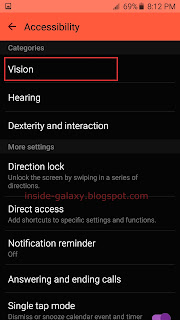How to enable and setup colour adjustment feature?
You can do so by using the following steps:
- In any screen, swipe down the top of the screen to open up the notification panel and then tap
 at the top right to go to the settings menu.
at the top right to go to the settings menu. - Scroll down to the Personal section and then tap Accessibility. FYI, if you have enabled the direct access feature, you can easily access the accessibility menu via the direct access menu by pressing the Home key three times.
- Tap Vision.
- Scroll down the screen and then tap Colour adjustment.
- Slide the ON/OFF switch to the right to enable colour adjustment feature.
- Tap Start button to start configuring colour adjustment feature.
- Here, you're provided with a set of colours. Arrange them in the order of similarity, starting from the fixed colour on the bottom panel. You have to select the colour that is most similar with the previous one. You can drag and drop to rearrange the colours when you have placed them in the wrong position in the panel. FYI, to find the best result, do this initial colour adjustment process when you're in an environment with normal indoor lighting.
- Tap Done button when you have finished arranging the colours.
- If your phone determines that you're not colour blind or having difficulty to read the colours on the display, your phone will tell you that the colour adjustment is not necessary to do.
- If your phone determines that you're colour blind or having difficulty to read the colours on the display, you'll be asked to fine-tune the colours on the screen. You can either tap Camera or Image to continue the process. As the example, we'll select Image.
- Adjust the colours on the screen by sliding the colour adjustment bar to the right or left until you find the best one and then tap Done button to save the changes.
- The colour adjustment will be applied to your phone.
- If you'd like to re-start the initial process of the colour adjustment feature, you can reset the current result and start the new one by tapping Reset and then follow the on-screen instructions.








































